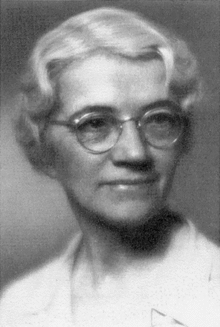Helen T. Parsons
| Helen T. Parsons | |
|---|---|
 | |
| Born |
March 26, 1886 Arkansas City, Kansas |
| Died |
December 30, 1977 (aged 91) Madison, Wisconsin |
| Nationality | American |
| Fields | biochemist |
| Institutions | University of Wisconsin |
| Alma mater |
Kansas State Agricultural College, University of Wisconsin, Yale University |
| Doctoral advisor | Lafayette Mendel |
| Other academic advisors | Elmer McCollum |
| Known for | B vitamins |
Helen T. Parsons (March 26, 1886; Arkansas City, Kansas – December 30, 1977; Madison, Wisconsin) was an American biochemist.[1] She developed early work in B vitamins.
Early life and education
Parsons was born in Arkansas City, Kansas. Her family believed in education and had a scholarly tradition.[1] Her father was a physician, who made house calls in the prairie.[1] She farmed during high school and saved money from a tomato crop to attend teachers' college in Pittsburg, Kansas.[1] She studied home economics in teachers' college, eventually attending Kansas State Agricultural College.[1][2] In 1913, she went to the University of Wisconsin to begin graduate study. There, Abby Marlatt, head of home economics, offered her an assistantship for graduate study. She studied under Elmer McCollum, observing original work on vitamin A and the naming of fat-soluble A and water-soluble B.[1] In 1916, she received her master's degree on the dietary properties of potatoes. Published in 1918, she showed that the dietary properties of the potato are much like that of cereal grains.[3]
Working in McCollum's lab, Parsons had access to the nation's first colony of white rats for use in nutrition experiments. In the following year, Parsons went with McCollum to Johns Hopkins University to work in the School of Hygiene and Public Health. Here, Parsons made a major breakthrough. Unlike humans or guinea pigs, rats did not need the anti-scorbutic substance in their diets. Anti-scorbutic agents assist in counteracting scurvy. She hypothesized that the rat does use water-soluble C but gets it in some way other than in food. In 1920, Parsons returned to Wisconsin to take a faculty position and conduct research on Vitamin C requirements.[1]
Doctoral work and career
Parson began her doctoral research under Lafayette Mendel at Yale University.[1] She received the Mary Pemberton Nourse Fellowship from the American Association of University Women.[1] At Yale, Parsons noted that high amounts of phosphorus and egg white incurred changes in rats' kidneys. They developed severe dermatitis and neurological dysfunction, and failed to thrive. She finished her Ph.D in 1928, and with the help of Marlatt, obtained funding by the 1925 Purnell Act for a project. She returned to Wisconsin as an associate professor and continued her work on egg white.
Later career and life
In 1942, Parsons' second series of papers was on live yeast interfering with utilization of dietary thiamin by humans. Companies had been advertising live yeast as a good source of vitamins, but they found that live yeast interfered with the utilization of thiamin from other dietary sources in humans and rats. She retired in 1956, spending time to garden and receiving accolades for her local work.[1]
References
- 1 2 3 4 5 6 7 8 9 10 Dorothy J. Pringle and Patricia B. Swan (January 1, 2001). "Helen T. Parsons (1886–1977)". Journal of Nutrition. American Society for Nutrition. 131 (1): 6–9. ISSN 1541-6100.
- ↑ Minds @UW oral tradition archived
- ↑ THE DIETARY PROPERTIES OF THE POTATO -The Journal of Biological Chemistry